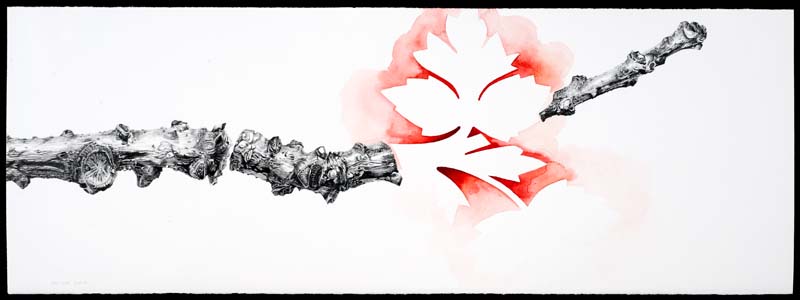
Natural Motif
In the Natural Motif series of drawings on paper and wall, I graft together elements of plant detritus with decorative motifs from Victorian wallpapers. The source plant matter is small, such as the inch-long twig drawn in Fractionate (2009), though in the drawings they are significantly magnified and begin to take on the air of bones or grotesque, fleshy appendages. The drawings are spare, like the backlit image through a microscope or a Spartan museum presentation. The red in many of the pieces evokes the process of staining otherwise invisible samples on a specimen slide and has the visceral overtones of blood. The Victorian motifs haunt the images like Platonic ideals—universal answers to the twigs' particularity.
The Natural Motif series initially evolved out of a decade among scientists at the University of Wisconsin-Madison. Through discussions with researchers such as Dr. Theresa Grana (developmental biologist, now at the University of Mary Washington), Dr. Kelly Aukema (biomolecular chemist, now at University of Minnesota), and Dr. Burr Settles (computer scientist, now at Carnegie Mellon University), I came to view nature as puzzle of knowns and unknowns, and science as a process of elaborating, inducing, and deducing patterns from a seemingly infinite field. I've been particularly influenced by the idea of the individual as a particular "ornament" within the overall "pattern" of its species and environment—a perspective originally put forth by the 19th Century German biologist and artist Ernst Haeckel.
My current work was also shaped by a formative time living in Cambridge, England in early 2007. There I met the work of Victorian designers whose patterns embellished the college halls and museums with nature-based motifs, such as William Morris and Dr. Christopher Dresser. These decorative motifs looked back at me from the dawn of biology: in the 19th-century scientists were just beginning to suspect the underlying patterns of genetics that governed growth and form. Especially Dresser's patterns reflected the budding science of the era, and I began to quote them in my work like the ghosts of patterns suspected, but not yet fully known.
Upon my return to the states, I was awarded a Wisconsin Arts Board Fellowship in 2008 for my work engaging art and science.
- NJS, (rev. 2010)
















